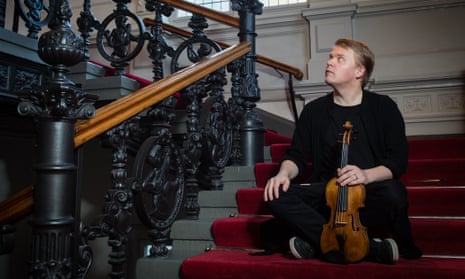What was the first recording you ever bought?
Diggi Loo Diggi Ley by Herreys, after the three brothers won the 1984 Eurovision song contest. Did you know that the oldest one of the bunch, Per, is now a lawyer for the Swedish musicians’ union? I sometimes imagine him wearing golden shoes while sorting out arguments between record labels and managers.
Here’s the performance:
What is your musical guilty pleasure?
Vibrato.
If you found yourself with six months free to learn a new instrument, what would it be?
The ondes Martenot. I think most ondists are keyboard players, and you need somebody with those skills for something like Turangalîla. For the creation of new ondes Martenot music, it would be interesting if more string players, wind players and singers had access to the instrument, since its personality feels like a kind of cross-breeding experiment between all those things. Also, I think the ability of the ondes Martenot to play very high notes extremely loud, while still sounding ecstatic and free, would be a great lesson for me and any other violinist or cellist sounding like a mosquito on speed in the Louanges of Messiaen’s Quartet for the End of Time.
Here is Messiaen’s Fetes des Belles Eaux, a composition for six ondes Martenot:
What single thing would improve the format of the classical concert?
Improvisation. Not only in the music being performed but in everything that happens inside the concert hall. I think we should try different gestures more often, even when there’s a risk of looking like an ass. Maybe especially when there’s a risk, or rather, an opportunity, to look like an ass. I’m not particularly excited about the persona of the performer overshadowing the repertoire, but I often feel the nature of the concert makes us performers seem detached and alien in a way that might actually obscure the message in the music. The audience should not always be allowed to sink into a comfortable familiarity at a concert, but they should be derailed in all kinds of ways that scratch the skin of whatever organs they receive their experiences with.
Which conductor or performer of the past would you like to have worked with?
From the recent past, I’d say Carlos Kleiber would be a pretty solid choice. I’d love to have felt the way musical gravity seemed to obey him.

What is the most unusual place you’ve performed in?
Possibly the paper mill in Fray Bentos, Uruguay. I was young and I needed the money.
What has been your most memorable live music experience as an audience member?
As a very young man, I heard Miriam Fried and Janos Starker play the Franck Sonata on consecutive nights at the Naantali festival in Finland, both with excellent pianists. Being a child at the time and studying the technical aspect of violin playing, I was surprised by how differently the artists approached the same work. If this kind of programming became more common, it perhaps would enhance the understanding of the nature of notation, and how difficult and essential it is for a performer to find her or his way of coexisting with a work, rather than just reading it.
One concert that floored me a few years ago was a show by Antony and the Johnsons. I had no idea anyone’s voice could tear me apart, but Antony’s did, and it hurt, and I became a better person. Antony is creating almost frighteningly important pop music as Anohni now, but here’s a memory of the old band, together with the Metropole Orkest, completely living and breathing the Beyoncé hit Crazy in Love.
We’re giving you a time machine: what period, or moment in musical history, would you travel to and why?
Bach improvising, or singing quodlibets with his family. I’d probably feel utterly pedestrian, but it would be worth it. Another moment I’d love to see is when the first caveman has started singing and is rather enjoying it, and the second caveman comes up and starts to hit some rocks against each other for a beat. Does the first caveman then say: “Thanks a lot, now you’ve ruined it”?
Which non-classical musician would you like to work with?
Radiohead. There’d be six of us, so we could get some ondes Martenots and play that Messiaen piece I posted above, over some pints.
Imagine you’re a festival director with unlimited resources. What would you programme – or commission – for your opening event?
First, I’d hire the best PR people and Al Yankovic to produce the most intense three-year ad campaign for polka. After three years of that, when the festival finally arrives, I’d put a special booth at all Sainsbury’s shops where people could bring their knives, guns and violins, and get an accordion in return. By then, thanks to the ad blitz, polka would be bigger than the Beatles and Jesus, so everyone would go for it. London would be full of polka and free of violence.
What do you sing in the shower?
The theme from the Disney animation Beauty and the Beast, with improvised lyrics about everyday events.
It’s late, you’ve had a few beers, you’re in a karaoke bar. What do you choose to sing?
The Backstreet Boys hit I Want It That Way, by Max Martin and Andreas Carlsson.
- Pekka Kuusisto performs at the Proms on 5 August and at the Edinburgh international festival on 23 August.

Comments (…)
Sign in or create your Guardian account to join the discussion